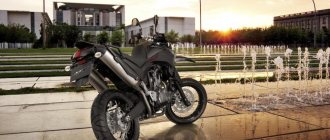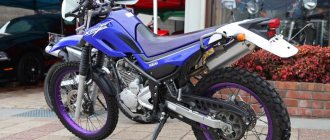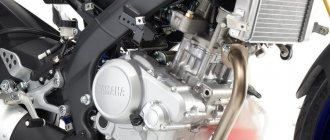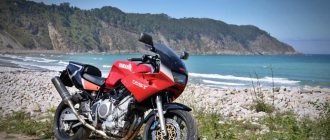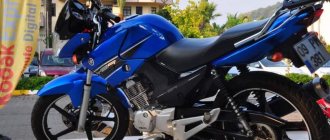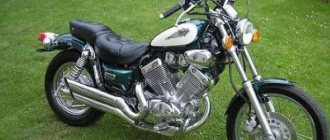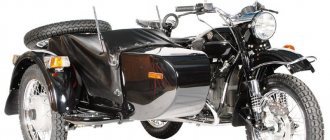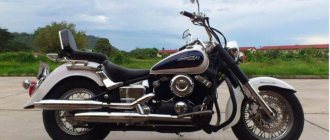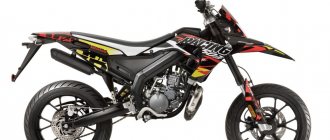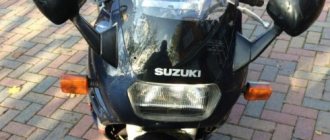Description of the motorcycle
In terms of engine power, the Yamaha XV 1700 Warrior is somewhat weaker than the custom Honda VTX1800 with its classic forms, but in appearance it differs quite noticeably. The new vision of style by Yamaha designers has led to the fact that all descriptions of the motorcycle are replete with poetic comparisons. A pumped-up handsome man with a flying silhouette, a powerful and harmonious engine in all details, cast but seemingly weightless wheels on three spokes, a smooth transition from the gas tank to the saddle really deserves words of praise. The designers decided that the huge muffler pipe also contributed to the overall style, but many owners began tuning their iron beast by replacing this particular part. But the taste and color, as they say.
By the way, the beast is not as iron as it might seem at first glance. The powerful, thick, black-painted frame is not steel at all. To make the structure lighter, it is made of aluminum alloy.
Yamaha Warrior Club
Yamaha XV 1700
cruiser model series appeared in 2002 and began with the Yamaha XV1700 Road Star Warrior . The model was built on the basis of a new engine, which was based on the engine from the previous version of the Yamaha XV1600, which increased its volume from 1602 to 1670 cm³, received a new cylinder head, an injection power system with two throttle valves and a “sports” exhaust system, which made it possible to issue this engine has up to 84 hp. power and up to 135 Nm of torque.
The Yamaha XV1700 Road Star Warrior model itself positioned itself in the style of a power cruiser and was distinguished by a number of technological solutions: an aluminum tubular frame, an inverted fork, powerful front brakes from the sports R1. Since 2005, a modification of the Yamaha XV1700 Road Star Midnight Warrior was available, which was distinguished by a black color and a minimal amount of chrome parts.
The main competitors of the Yamaha XV1700 in the class:
- Honda VTX 1800
- Kawasaki VN1700 Vulcan / Kawasaki VN 1600 Vulcan Mean Streak
- Suzuki VZ 1600 Marauder / Suzuki Intruder M1500 (Boulevard M90)
A Brief History of the XV1700PC Road Star Warrior
- 2002 – start of production and sales. Factory designation : 5PX1, 5PX2, 5PX3.
- 2003 – no significant changes. Factory designation : 5PX4, 5PX5, 5PX6, 5PX7, 5PX8, 5PX9.
- 2004 - without significant changes, the appearance of the classic XV1700A and the Silverado touring modification. Factory designation : 5PXA, 5PXB, 5PXC.
- 2005 - no significant changes, version available in black (Midnight). Factory designation : 5PXD, 5PXE, 5PXF + 2D81, 2D82, 2D83
- 2006 – no significant changes. Factory designation : 5PXG, 5PXH, 5PXJ + 2D84, 2D85, 2D86
- 2007 – no significant changes. Factory designation : 5PXK, 5PXL, 5PXM + 2D87, 2D88, 2D89
- 2008 – no significant changes. Factory designation : 5PXN, 5PXP, 5PXR + 2D8A, 2D8B, 2D8C
- 2009 – no significant changes. Factory designation : 5PXS, 5PXT, 5PXU + 2D8D, 2D8E, 2D8F
- 2010 is the final year of Warrior production. Factory designation : 5PXX + 2D8J
Specifications
| Model | Yamaha XV1700PC |
| Motorcycle type | cruiser |
| Year of issue | 2002-2015 |
| Frame | Aluminum tubular |
| engine's type | 2-cylinder, 4-stroke, V-shaped |
| Working volume | 1670 cm³ |
| Bore/Stroke | 97.0 x 113.0 mm |
| Compression ratio | 8.36:1 |
| Cooling | air |
| Number of valves per cylinder | OHV, 4 valves per cylinder (lower camshaft) |
| Fuel supply system | Injector, 2x Mikuni AC40 |
| Ignition type | transistor TCI |
| Maximum power | 84.3 hp (62.0 kW) at 4400 rpm |
| Maximum torque | 135.0 Nm (13.6 kg*m) at 3750 rpm – Warrior |
| Clutch | Multi-disc in oil bath, cable drive |
| Transmission | 5-speed |
| type of drive | belt |
| Front tire size | 120/70-ZR18 M/C (59W) |
| Rear tire size | 200/50-ZR17 M/C (75W) |
| Front brakes | 2 discs, 298 mm, 4-piston radial calipers |
| Rear brakes | 1 disc, 282 mm, 1-piston caliper |
| Front suspension | 41mm inverted fork, 135mm travel |
| Rear suspension | pendulum with monoshock absorber (adjustable preload and rebound), stroke 110 mm |
| Motorcycle length | 2385 mm |
| Motorcycle width | 955 mm |
| Motorcycle height | 1120 mm |
| Wheelbase | 1665 mm |
| Seat height | 725 mm |
| Minimum ground clearance (clearance) | 155 mm |
| Acceleration to 100 km/h | 3.9 sec |
| Maximum speed | 201 km/h |
| Gas tank capacity | 15.0 l (including reserve - 3.0 l) |
| Motorcycle weight (curb) | 295 kg |
Fuel consumption
The officially declared fuel consumption for the XV1700 is: 6.53 l / 100 km for the classic versions of the XV1700A, 5.78 l / 100 km for the Warrior. The exact value depends on your riding style.
Dashboard
The characteristic decoration of the Yamaha Road Star Warrior 1700 motorcycle is the dashboard. It is very technologically advanced, which is not typical for motorcycles, but is typical for Japanese manufacturers.
Above the headlight, in chrome trim, there is space for a large dial-style speedometer and an LCD digital tachometer. When the engine is turned on, the instruments flash and shimmer, and at night the backlight not only helps to read the instrument readings without problems, but also looks very beautiful.
Yamaha XV1700 Review (XV1700A, Road Star, Warrior, Silverado)
The Yamaha XV 1700 cruiser model series appeared in 2002 and began with the Yamaha XV1700 Road Star Warrior model. The model was built on the basis of a new engine, which was based on the engine from the previous version of the Yamaha XV1600, which increased its volume from 1602 to 1670 cm³, received a new cylinder head, an injection power system with two throttle valves and a “sports” exhaust system, which made it possible to issue this engine has up to 84 hp. power and up to 135 Nm of torque.
The Yamaha XV1700 Road Star Warrior model itself positioned itself in the style of a power cruiser and was distinguished by a number of technological solutions: an aluminum tubular frame, an inverted fork, powerful front brakes from the sports R1. Since 2005, a modification of the Yamaha XV1700 Road Star Midnight Warrior was available, which was distinguished by a black color and a minimal amount of chrome parts.
In 2004, the successor to the Yamaha XV1600 was finally introduced - the Yamaha XV1700A Road Star. Visually, the spoked versions of this model were practically no different from the previous XV1600. However, in parallel, versions with alloy wheels and touring modifications of the Silverado were offered, which were distinguished by a touring body kit - a backrest, leather trunks, windshield, etc. Silverado was also available with spoked or alloy wheels.
In 2005, a modification of the Yamaha XV1700 Road Star Midnight Silverado appeared - a version similar to the Silverado with alloy wheels, but in black and with plastic lockable panniers.
The Yamaha XV1700A was based on an engine from a Yamaha Warrior with a different cylinder head, exhaust system and carburetor power system. This engine was in many ways reminiscent of the engine from the previous version of the XV1600. It is noteworthy that Yamaha has not officially stated the maximum characteristics of this engine, so many sources indicate characteristics similar to the Warrior engine. However, it was possible to find American data obtained from a dyno stand, characterizing the power and torque at the rear wheel - 61.1 hp. / 126.2 Nm.
2006 was the last year of production for the alloy-wheel version of the Silverado, while 2007 was the final year for the regular spoked-wheel version of the Road Star.
In 2008, the Yamaha XV1700A receives an injection power system instead of a carburetor. S-modifications of the Road Star also appeared, which were distinguished by a chrome package.
2010 was the last year of production of the Warrior modification and the spoked version of the Silverado.
2015 was the final production year for the classic and touring version (Silverado) Road Star, after which they left the market and were no longer offered.
Motorcycle dimensions
The motorcycle is based on the famous Long & Low principle, that is, long and low.
Dimensions of the Yamaha Warrior XV 1700 RS (L × W × H): 2.4 × 0.92 × 1.12 m. At the saddle, its height is 0.7 m, ground clearance - 11.5 cm. With a wide wheelbase 1 .7 meters and a fairly low seating position, typical of choppers with arms and legs extended forward, the motorcycle is easy to control. The low ground clearance and wide footpegs are felt when there is a need to make a sharp turn, but under normal conditions this is rather a plus of the design.
The low silhouette, combined with a specific landing position, allows the pilot to feel quite confident behind the controls even at speeds approaching 150 km/h, which is not typical for conventional cruisers.
Motorcycle engine
The two-cylinder four-stroke engine is not fundamentally new. It's largely a switch from the proven XV1600 Wild Star. The engine is made according to the traditional design with four valves, two spark plugs for each cylinder, the drive of the upper valves from the lower camshaft, a separate block with a chain motor transmission at the gearbox and a dry sump lubrication system, allowing for sharp maneuvers and tilts without the risk of disrupting lubrication.
The Yamaha Warrior 1700 engine is distinguished by its cylinder diameter increased to almost 100 mm, forged pistons instead of traditional ones, and an injection system.
Thanks to this scheme, parasitic vibrations and engine noise are minimized. Some lovers of power in everything consider this last advantage to be rather a disadvantage. Some bikers add elements to the design of the exhaust pipe so that the roar of the engine makes a lasting impression on others.
The power of the 1.7 liter engine reaches 85 hp. accelerates a motorcycle with a curb weight of 300 kg to a maximum speed of almost 200 km/h. Maximum torque is achieved at 3750 rpm. It is 135 Nm.
Suzuki M 109 R Boulevard (2006 – present, 400,000–850,000 rub.)
Suzuki engineers are used to going beyond what is reasonable. How else can one explain the appearance of such a steroid-fed monster as the Suzuki Boulevard M 109 R (aka Boulevard M 109 R, M 1800, VZR 1800 and Intruder 1800). Regarding materiel, we have a very thick mix of a sportbike and a cruiser.
Engine
The "M" in the title stands for Muscle. “Muscularity” is primarily dictated by the power unit. Seriously sized (piston diameter 112 mm!) two-cylinder V-shape with a semi-dry sump, liquid cooling, fuel injection, two camshafts and four valves for each cylinder is stuffed in a sportbike style. Inside, there are forged aluminum pistons, chromium nitride coated oil rings, a reinforced crankshaft and chrome-moly connecting rods. Thanks to six silent blocks between the frame and the engine, there are not many unpleasant vibrations. The Boulevard engine loves very attentive maintenance, mainly due to the fact that it eats up oil with a decent appetite at high speeds. This behavior is not a malfunction, but a feature that should be taken into account. If you frequently drive at full throttle, the engine oil level should be checked before each trip. The semi-dry sump lubrication system does not like oil overfilling above the level. The excess is immediately squeezed out into the air filter.
Transmission
Due to careless use, the clutch often fails prematurely. It is difficult for him to resist a large powerful engine. On motorcycles produced before 2008, problems with the five-speed gearbox may occur. Torque is transmitted to the rear wheel by a driveshaft. It is almost impossible to “roll” it ahead of time. Plays and crunches can only appear from negligent maintenance.
Frame and body kit
Suzuki engineers deliberately did not switch to aluminum frames. The gain would be insignificant. For the M 109 R, the rigid steel structure proved justified. We limited ourselves to only an aluminum pendulum. The body kit, unfortunately, is not very durable. There are a lot of plastic parts and almost all of them are quite thin. Even a small accident can cause serious losses in terms of aesthetics. The blind plug at the rear does not contain the passenger seat underneath!
Brakes
The radial four-piston front calipers are not efficient enough for the heavy weight of the Boulevard M 109 R. Often you have to save yourself with the rear brake, which is not very informative.
Pendants
“Boulevard” is a big guy, and he needs appropriate pendants. The motorcycle rests on the asphalt with impressive size rubber “slippers” (130/70–18 and 240/40–18) through an inverted Kayaba fork with feathers as much as 46 mm. At the rear is a Link-type swingarm with single Kayaba shock absorbers. Brutal, not exactly very tough, but functional and definitely outside the genre.
Comfort
Comfort in this case is a constant value. The wide seat and the driver's footrests pulled forward create a completely relaxed driving position. You can and should go far! The passenger will also be comfortable. Adequate speed limit for the Suzuki Boulevard M 109 R is 120-160 km/h with occasional fleeting accelerations.
Modifications
In 2007 and 2008, the motorcycle received a slight cosmetic makeover. In 2008, in addition to the base model, a purely image special version, Boulevard M109R Limited Edition, was released (stripes across the entire motorcycle, transparent lighting fixtures, etc.). Autumn 2013 Suzuki has announced the completely chrome-free M109R BOSS (Blacked-Out Special Suzuki). From 2009 to 2011, the Suzuki Boulevard M 109 R 2 was produced - a special version that differs from the base M 109 R in lower dry weight, headlight, body kit parts and ergonomics.
Chassis and transmission
The Yamaha Warrior motorcycle engine is paired with a five-speed manual transmission. The main gear is V-belt, ensuring smooth running.
The brake system, borrowed from the YZF-R1 sportbike, which in itself already characterizes its reliability, is disc: the front brakes are double-disc, the rear brakes are single-disc. A motorcycle that is not heavy enough stops very quickly; the front brake can even block.
Radial tires with a diameter of 120 mm on the front wheel and 200 mm on the rear wheel, Dunlop Sportmax, allow you to feel confident both on sharp turns and on wet asphalt.
The front suspension is an inverted fork with a small stroke of 135 mm. At the rear, thanks to a central monoshock absorber with a progressive characteristic, even a loaded Yamaha Warrior motorcycle can quietly overcome potholes on the road surface.
Tire selection
Yamaha didn’t limit itself to an aluminum frame, sportbike brakes and an inverted fork; the Warrior’s wheel sizes are also completely non-chopper. The front is 120/70-18 like the Honda X4, and the rear is 200/50-17 like the Kawasaki ZX12R. Accordingly, you won’t find tires with a classic chopper pattern. With white sidewalls too - no one produces it. Everything suitable will have a modern design with a sports and tourism focus. A set in standard sizes can be supplied from the cruiser Metzeler ME880 Marathon.
If you don’t bother with the 200th wheel, but install a 190/55, which will look thicker due to the fact that it is higher, then the choice expands significantly. Michelin Pilot Road 4, Metzeler Roadtec Z8 and Roadtec 01, Dunlop Roadsmart 3, Pirelli Angel GT and five more models are added, of which I would especially like to mention the Korean Shinko 011. It costs little and surpasses the power and geometric capabilities of Warrior in terms of grip properties. 210/50 fits back without problems, 240/40 can also be pushed in, but it looks like a poisonous mushroom with a bent cap. It is better to abandon the 130/70 setting, as handling is greatly deteriorated.
The Suzuki M109R was the first mass-produced motorcycle with a 240/40-18 rear balloon. Before him, such wheels were used only by customizers in one-piece and small-scale devices. At the time of release there were few offers in this size, now finding something is not difficult. I would recommend the Metzeler ME888, Pirelli Night Dragon, Michelin Commander II and Avon Cobra. You can stretch the tire up to 160/60–18 on the front disc, and 280/35 on the rear disc with the help of a tambourine, but on such wheels the motorcycle stops turning, rides only in a straight line and tries to jump out of the rut sideways on its own. So forward only standard size, back 260/40 maximum. Among the budget options on the market, there are Shinko SE890 forward and 005 backward, but both of these wheels do not hold up very well on wet asphalt, and I can only recommend installing them as a temporary measure to get home.
I would strongly advise against installing a car rear wheel. The motorcycle on it behaves inappropriately on uneven roads and resists turning. The damage can be two orders of magnitude greater than the savings on the tire.
Denis DEAN Panferov www.motorezina.ru
Puncture doctor > August 23, 2022 12:11 Mikhail Pimus
Specifications
A fairly heavy bike, if you need to do it quickly, accelerates to hundreds of kilometers per hour in 3.6 seconds. The acceleration dynamics allow you to drive freely in traffic and confidently overtake. According to the passport, the maximum speed of the Yamaha Warrior XV 1700 motorcycle is 190 km/h.
On average, fuel consumption is less than 7 liters per hundred km. It rises to this level only at speeds of 150 km/h. That is, with a fifteen-liter tank you have to look for a gas station every 200 km, which, of course, does not cause delight among lovers of long trips.
The most economical ones managed to travel 250 km at one gas station. But this is rather an exception to the rule.
Tuning and additional equipment
In addition to airbrushing and repainting the motorcycle in unusual colors just for fun, tuning the Yamaha Warrior 1700 necessarily includes equipment for a passenger seat. The passenger backrest allows a very small and inconvenient place for the second number to be made at least a little more comfortable and safer. Moreover, a modified exhaust, for example, Vance&Hines BigShots, in addition to its beauty and deep sound, can burn the legs (oh, no, legs) of a charming blonde even through the overalls, if it is not leather.
The protective arches may not carry any meaning if you drive slowly and carefully. But on the road, and especially in traffic jams, anything can happen. Therefore, they not only give solidity and are used as handles for lifting a fallen “horse,” but also protect against those who want to push back the impudent person with physical force.
A high windshield is also not installed for beauty. At speeds above 100 km/h it protects from the oncoming flow of cold air, and at higher speeds it reduces the tension in the muscles of the neck and back when resisting the same oncoming air flow.
Heated handles are also not a whim. Anyone who rides a high-speed motorcycle not only in the summer will understand. Spherical mirrors add style and, most importantly, allow you to see what is happening behind you in the blind spot.
Something else that is important for travel, but can ruin the appearance of a fast and predatory motorcycle, is the panniers. Stitched leather saddlebags must definitely match the style of the iron horse.
The soundtrack includes not only the roar of a powerful engine. Many pilots replace the stock horn with something more appropriate, such as a Hadley horn.
The first “childhood delights” of owning a motorcycle are far behind us; it’s time to sum up the results of the second season. 18 thousand have been passed, there is something to talk about and something to complain about. Although the motorcycle is certainly good. UPD: the review after the 1st season is here. In this review I will only talk about new impressions.
18 thousand have been passed, there is something to talk about and something to complain about. Although the motorcycle is certainly good. UPD: the review after the 1st season is here. In this review I will only talk about new impressions.
Briefly
Pros: + Not bad (for a cruiser) versatility of use + Dynamics + Handling + Appearance + Brakes + Humane fuel consumption Cons: - 6th gear is missing - Ergonomics in long-distance driving are lame - Carrying luggage is not ideal - Complete absence of mechanical aftermarket (body kit not included) account) - Confused (by chopper standards) device and maintenance
Flaws
I'll start with them, it's better to leave the good for last.
1. They say that every motorcyclist on the highway needs one more gear. I can’t speak for everyone, but on Warrior the 6th is clearly asking for it. Objectively, the Warrior’s gearbox is good, the closely spaced gear ratios are AWESOME! But at speeds above 130, another step is requested. And it’s not just that after 4000 rpm the engine starts to turn sour. What’s more important is that: — After 3500 there are childish vibrations that you can’t drive with for long. — Consumption at 150 km/h rises from 6 to 7 liters, which begins to depress with a 15-liter tank
I couldn’t find any relatives for my model (which is logical) or even an aftermarket. In general, no one seems to produce aftermarket mechanics for Japanese cruisers - an obvious competitive advantage of Harley, for which many different companies make engines, gearboxes, and much more mechanical stuff. Just for fun, I looked at other Yamaha models: - all choppers - 5 steps - V-Max (both old and new) - also 5 steps - even the FJR1300, seemingly a sport-tourer - again 5 steps. Just some kind of conspiracy. I looked at the rest of the Japanese, almost all cruisers again have a 5-speed gear. An uncharacteristic exception was the Kawasaki VN1700, suddenly 6 steps! If it weren’t for the dead engine (73 hp) and the generally “crappy” design, I would have taken a closer look at it... But HD and Victory have been producing cruisers with 6 speeds for several years now.
My first thought was to play with the gear ratios using the driven/driven belt in order to reduce the operating speed at the same speed. The operation is quite real, certain Harley pulleys are installed, the belt is changed and, in principle, that’s all. However, acceleration becomes more “vegetable”, which is not at all cool in the city. Or it may be ice, but then there may still be a problem with reconfiguring the speedometer.
But if you change gear ratios, would it be nice to invigorate the engine? That was the second thought. A couple of years after the model was launched on the market, Yamaha began selling Speedstar series parts. The power increased from 86 to 104 hp, I don’t remember the torque numbers. As of now, it is impossible to assemble the kit completely; apparently, it is no longer produced. In theory, you can use the engine from the MT-01, they are the same in size, and the um-te-shka is still in production. But in practice, the amount of work required for this +4hp. and +15Nm still needs to be studied...
Diagnosis: almost no cure. Trying to fit an American engine and a 6-mortar into the frame is a direct path to welding/grinder. Then it’s easier to make a custom from scratch.
2. The canons of the class dictate the features of landing and ergonomics in general. Due to the far-out footpegs, the entire body weight falls on the 5th point, thanks to the fact that at least the saddle is wide and you can change your seating position a little while riding. The “stick” steering wheel, although not original, still forces you to reach forward and almost climb onto the tank. Handling in the city is good, but on the road you get tired quickly: - 5-6 hours on the road are not stressful at all, you can stop only when necessary to refuel - after 700 km you still have strength, but along the way you want to stop more often - 1000 km is a conditional limit, when more or less normal, but it’s better not to go further in one sitting - after a thousand, fatigue grows non-linearly, 1200 is basically passed (checked three times), but 1500 - a “motorcycle overdose” sets in, when all parts of the body try to fall off and you don’t want to look at the motorcycle a couple more days.
Red zone: fatigue after 700 km (right leg, collarbone), yellow - after 1100 km (5th point, lower back, arms, neck)
Once again about vibrations. They are transmitted especially strongly to the running boards (I ride in sports plastic boots, so the shoes do not extinguish them), and after a long road they also radiate to the 5th point. Perhaps it can be treated by installing arches with extensions, but you have to try. The arcs must be installed in any case, the question is where: the most obvious place for the upper fasteners is the starter bolts, which is not good and what I already ran into with the old arcs (they fell off after a couple of incidents). If you drive for a long time, then in addition to this, your right leg will go numb, due to the protruding side air filter, and your arms will go numb due to the not quite straight landing.
Diagnosis: treated by replacing the steering wheel, possibly the saddle, stems, and windshield. But the problem will not disappear 100%.
3. The mileage on a tank “dry”, if you save fuel, in theory no more than 250 km, the maximum reached 230 (not from a good life), I prefer to refuel after 150-200 km. On a long journey or in cold weather, you have to stop every 100-120 km, due to fatigue and poor wind protection. I don’t know if there are higher windshields, but something definitely needs to be decided - I’m tired of depending on the weather, and depending heavily. The same applies to heated grips.
Specific ergonomics and a small tank affect the average speed on the highway. According to the stories on the BP, an average of 90 km/h over 1000 km of travel is considered quite normal speed even for cruisers. I only managed to do the average 100 once (Voronezh-Moscow, only 500 km), for 1000 km or more the average did not rise above 75. Despite the fact that most of the road I was driving 120-150.
Diagnosis: a new tank is needed, at least 20 liters.
4. There are also complaints about the transportation of luggage. Firstly, you can’t carry heavy loads on the trunk; this will deform the wing (although maybe this is for all cruisers?) Secondly, I still haven’t been able to find normal-looking panniers (or Corbin’s plastic ones for $2000-3000 for set). For the coming season, I’m thinking of taking some simple textile side skirts, so as not to fool my head, it’s cheap and cheerful.
The deformation zone of the rear wing is highlighted in red.
In the 2012 season, I dealt with luggage extremely simply: I placed a large backpack with a heavy load on the back seat, a smaller and lighter backpack on the trunk (after I discovered deformations of the rear fender), wrapped it all in conditionally waterproof covers and tied it with spiders behind passenger backrest and trunk. It held tightly and fit well. It didn’t affect the handling at all, despite the fact that the central trunk, even on the Electric Train, seems to add hemorrhoids when driving.
5. I think I already wrote about the “convenience” of maintenance (in comparison, even the ergonomics are ideal!). Although most of the work is done with standard tools included in the 100+ element set, strong and flexible fingers still do not hurt. So, we have the following: — two air filter housings (two!!!11), to replace the filters you need to remove the tank; — removing and putting the tank in place must be done by two people; long strong fingers and a good eye are required, otherwise the pipes will not fit where they need to be; — to replace the spark plugs, you need to remove the upper air filter housing, the procedure is extremely frustrating: very dense laying of wires and other various hoses at the work site, plus it’s difficult to put rubber bands on the intake pipes when you’re not used to it. If you have a cardan spark plug, you can do without this, but the manual says to do it by removing the filter. It may be easier to adjust the tightening force this way;
Excerpt from the service manual: dismantling the upper air filter housing. Happy spark plug replacement, %BIKERNAME%!
— Of the 4 spark plugs, only two can be easily replaced, and one, the right one in the front cylinder, has to be changed by touch (or remove the steering wheel with the instrument panel, but this is beyond common sense); — with long forward flows, any operations on the rear axle (checking the belt tension, changing tires or, God forbid, replacing the belt) lead to the need to disconnect the exhaust, because the pipes overlap the axle. The stock exhaust does not cause such problems; — the belt, as it should be, is difficult to change; this requires removing not only the wheel, but also the pendulum. By the way, I have only seen tire belts (if the main one is broken) for Harleys, and then not for everyone. You cannot take a spare regular belt on long-distance trips (because it cannot be twisted, crushed, etc.). + but the oil filter is located very conveniently; installation/disassembly is perfectly accomplished using the most common chain wrench for oil filters costing 100 rubles. maximum.
6. Headlights and turn signals. The head light is not enough for driving at night. There is a lot of plastic around the rear turn signals, it is wrong and unaesthetic. Methods of treatment: a correctly selected chandelier or the right xenon, an integrated stopper (already purchased), at the same time it will be possible to replace the non-pont plastic shovel that mounts the license plate with a “boyish” metal platform with a mount on the rear axle.
About pleasant things
If such shortcomings have not yet confused you, read on...
The device is quite suitable for driving through traffic jams on Moscow highways (TTK, MKAD, wide radial highways), especially with the arches removed - you can make sharper maneuvers between cars. Long-range use is clearly no worse than road work, you drive slower, but you get tired slower and you can drive longer in one sitting. You can carry a lot of luggage without affecting handling.
Dynamics up to 100 km/h allows you to misbehave in traffic, up to 140 you can confidently overtake, but then the lower engine “deflates” and the vibrations get annoying. But driving at 120-130 is the most fun. Lack of hp and I rarely feel the moment, mainly when overtaking long lines of trucks on 1-lane roads.
Handling, braking: no complaints, although there is almost nothing to compare with. The rear brake performs very well; it is convenient to slow down on the highway. Only once during the season did I have to brake completely on my ears, on a wet road. The motorcycle skidded heavily left and right, but managed to stop before the truck. I was almost sure that I would fall, but it turned out okay, I just had to not disturb him. Along serpentines, the speed of movement depends on the intensity of the flow and how scared you are. Once we were riding through the mountains in a convoy with “neat” sports, I was not a burden. The softness of the suspension is comparable to the average settings of the R1200GS, and it absorbs bumps no worse. A hole in a turn remains just a hole, and not the beginning of “twisting” of the frame and not a struggle for the stability of the motorcycle. The only time my spine went into my underpants was on a really bad road surface and at high speed; this only happened at night on an unlit road.
The appearance still does not leave me indifferent, partly due to the body kit. In stock, especially with the original exhaust, the motorcycle doesn’t look nearly as interesting. By the way, the “wow factor” of choppers seems to grow as you move north - in the south almost everyone is “stick” to sports, in Moscow it’s 50/50, in Karelia they paid me much more attention 
Reliability. It’s worth banging your head against the wall, but I will do the “big” maintenance, with checking all the hoses, wiring, etc., only now, after 26 thousand miles. Until this time, I simply changed consumables according to the regulations; the only unscheduled change was the belt change after 49 thousand, which suddenly broke. At the end of the 2012 season, the motorcycle clearly decided to remind us of this, when first the clutch cable flew, then the powerful negative terminal of the main harness immediately broke, and before putting it in the garage, it generally refused to start with an incomprehensible crackling sound from the battery area (relay?..). In general, despite the hassle of maintenance, there are no complaints about reliability.
Ideal motorcycle
The description of the shortcomings took up much more space than the positive part.
Probably, I’m just being too picky; after all, more than half of my current mileage has accumulated on long-distance trips. What ideally I would like to see from my motorcycle: 1. Comfortable fit for the city and the highway 2. Good wind protection 3. Directional stability 4. Soft suspension without loss of control 5. Acceptable “anti-stacking” 6. Good brakes and dynamics (confident 150 highway, fast acceleration 70-150) 7. Stress-free transportation of 20..40 kg of luggage 8. Easy maintenance 9. A large number of aftermarket spare parts, both body kit and mechanics 10. Mileage on a tank of at least 300 km 11. Reliability 12. Appearance 13. The feeling of STUPID in the engine and the reserve of traction under the right hand from the very bottom. My device satisfies the stated criteria at least half, and if we take into account the last point, then even more . Am I ready to change it to something else, even with an unlimited budget - The question is open, because I have too little experience riding other motorcycles, just ride and ride. So far, I’m probably only ready to consider 2 other devices as my main motorcycle: 1. KTM Adventure 990R. Not a chopper of course, but V2 and everything else is great! 2. HD Road King. Harley and Trub in general, I wonder what it's like in a long distance. I'm captivated by the abundance of the aftermarket, scared away by the price, and for now it's a “pig in a poke” for me. Besides, remembering OcM’s story about a trip across America, it’s not a fact that Roadking will be so much better as to warrant buying it. Again, you have to travel. 3. UPD: (thanks to ZloYa) Victory Cross Country. According to many recent tests, the best, or one of the best baggers.
. Am I ready to change it to something else, even with an unlimited budget - The question is open, because I have too little experience riding other motorcycles, just ride and ride. So far, I’m probably only ready to consider 2 other devices as my main motorcycle: 1. KTM Adventure 990R. Not a chopper of course, but V2 and everything else is great! 2. HD Road King. Harley and Trub in general, I wonder what it's like in a long distance. I'm captivated by the abundance of the aftermarket, scared away by the price, and for now it's a “pig in a poke” for me. Besides, remembering OcM’s story about a trip across America, it’s not a fact that Roadking will be so much better as to warrant buying it. Again, you have to travel. 3. UPD: (thanks to ZloYa) Victory Cross Country. According to many recent tests, the best, or one of the best baggers.
In general, common sense is trying to tell me that cruisers are not particularly suitable for long-distance travel - they are just a little better than road bikes, and that humanity has come up with many other classes for such use: tourenduros, sport tourers, luxury tourers.
But I don’t want to exchange metal for plastic, the rough character of the V2 for a “refined” in-line or boxer, the bestial roar of large cylinders for the “sewing machine” of a riding motor. So I fully admit that it would be best to greatly alter your Warrior, or make a custom one based on its frame and chassis. They are too good for him
They are too good for him
Repair and spare parts
Motorcycle parts are mostly consumables. Front and rear brake pads, a set of air filters, an oil filter, oil are the main components of the list. The main problem, which is also expensive, is the tires, the front of which is a rather rare size, and its selection takes time.
And maintenance causes teeth grinding for everyone who is used to changing oil, filters and spark plugs on their own. Perhaps it did not occur to Japanese manufacturers that such things were not done in specialized centers, but the fact remains a fact.
The Yamaha Warrior XV 1700 requires at least two people to replace the air filters, since the fuel tank then needs to be removed and installed, which cannot be done alone.
Replacing the spark plugs is more or less simple for only two of them; with the rest you need to suffer; if you don't have pianist's fingers, you will generally have to remove the steering wheel and the dashboard. Replacing a belt is a long procedure; both the wheel and the pendulum are removed, but in this case no one was expecting any gifts.
The only thing that is easy when servicing yourself is replacing the oil filter. True, you need to purchase a chain wrench for oil filters, but in general this is not a problem at all.
Advantages of a motorcycle
The main advantage of the Yamaha Warrior is its versatility. It easily moves in traffic jams on the streets of big cities, especially without protective bars and panniers, and performs complex maneuvers. Handles long roads well, even with luggage it does not lose control at cruising speed. Pilots claim that the most comfortable speed on the road is 120-130 km/h.
Those who have something to compare with note the good handling, suspension and brakes. Of course, the advantage is the high reliability of Japanese technology. The motorcycle begins to require attention only after 25 thousand kilometers. Motorcycle parts closer to 50 thousand km are necessarily replenished with a belt, which, having worked for so long, can quite deservedly break.
Despite its size and powerful engine, the motorcycle is quite economical. He eats both oil and gasoline with a very moderate appetite.
Well, and of course, the appearance does not leave cold the hearts of connoisseurs of motorcycle beauty, especially those improved by body kits, leather trunks and other decorative and useful elements.
Disadvantages of a motorcycle
For the powerful Yamaha Warrior XV 1700 motorcycle, there is not enough sixth gear in the gearbox. All pilots note this and call it one of the main disadvantages of the motorcycle. However, almost all Japanese choppers and cruisers are guilty of this.
The second is considered to be insufficient ergonomics, especially for a passenger who can rarely withstand an hour of travel without rest. And due to the peculiarities of landing in accordance with the canons of the class, the pilot needs rest after five hours on the road to stretch his tired muscles.
Carrying luggage, even though its quantity does not affect handling, is a problem that each owner solves to the best of his imagination.
Pilots also cite the optics as a disadvantage. The light from the standard headlight is not enough; almost all owners immediately install xenon. And the rear turn signals with a lot of plastic fail almost at the first fall, and you have to install a metal platform to attach them.
The Yamaha Warrior turned out to be so original, at least for Russian lovers of thrills and speed, that drivers sometimes even run out of words to express the delight of riding, and are left with only emotions. Moreover, the shortcomings can be completely eliminated, because they do not spoil the pleasure of controlling a powerful and obedient predator.

